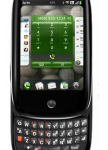 Now that we know the price and release date of the Palm Pre, I’d like to pour some fuel on the flames that are illuminating Palm (and Sprint’s) strategy for voicemail and other speech-enabled services. Yesterday, it was confirmed on Twitter (the veritable font of truth, among other things) that iPhone-like presentation of voice message headers in a vertical scroll for easy access is not a feature that the Pre will support.
Now that we know the price and release date of the Palm Pre, I’d like to pour some fuel on the flames that are illuminating Palm (and Sprint’s) strategy for voicemail and other speech-enabled services. Yesterday, it was confirmed on Twitter (the veritable font of truth, among other things) that iPhone-like presentation of voice message headers in a vertical scroll for easy access is not a feature that the Pre will support.
Since television commercials from Apple and AT&T Mobility used “Visual Voicemail” as a key differentiator at the time of the iPhone’s launch, disappointment among prospective buyers is understandable. However, there is another segment of mobile users who have pointed out from the beginning that the iPhone does not offer “visual voice mail” – meaning voice mail that you can see. Instead it offers access to traditional voice mail through a visual user interface. It is a not-so-subtle distinction that the likes of SpinVox, Nuance and PhoneTag (then called SimulScribe) have been quick to highlight.
More to the point, Pre (and probably Android) are going to put to the test the protocol for user access to “phone apps” that iPhone has made so popular. Pre, for instance, with its WebOS and “Synergy” (the name for its cloud-based approach to personal information management), will take a Web services approach to presenting applications, features and functions, including visual access and visual presentation of transcribed voicemail messages.
The advantages of such an approach – as explained by the three voicemail-to-text service providers mentioned above, among others – include the ability to read the transcribed message (or a reasonable transcription thereof), store the message with other messages associated with a particular contact and the ability to search stored messages when needed.
Apple and AT&T’s approach is decidedly disaggregated, but only marginally “recombined”. The ability to scan through voicemail headings and selectively play messages or initiate a callback was novel, but it hardly caused a nudge in the innovation needle. Meanwhile, new models for making phone calls and managing messages in multiple formats (including voicemail) are being launched by Google, IBM, Microsoft, Cisco, Avaya and a wide variety of entrepreneurial firms and phone application developers who understand the principles of disaggregation and recombination.
In short, a lot more information than the caller’s name and number can be presented as part of visual display of calling party information. It can look more like a Twitter Tweet, text message or even a promotional coupon. What’s more, a lot can be done with transcribed voicemail to support communications, interactions and even transactions. In the past we might have called it a “paper trail” that can jog our memory in this attention-fractured age. More accurately the new architecture has the ability to support multimodal, asynchronous conversation that are the underpinnings for new forms of phone-based conversations and commerce.
Categories: Articles

 2025 Conversational AI Intelliview: Decision-Makers Guide to Self-Service & Enterprise Intelligent Assistants
2025 Conversational AI Intelliview: Decision-Makers Guide to Self-Service & Enterprise Intelligent Assistants  Why Is ElevenLabs Building a Conversational AI Stack?
Why Is ElevenLabs Building a Conversational AI Stack?  Talk to the Web: How NLWeb Opens Conversational Access to Site Content
Talk to the Web: How NLWeb Opens Conversational Access to Site Content  Battling ‘Botenfreude’: The Power of People and Policy
Battling ‘Botenfreude’: The Power of People and Policy